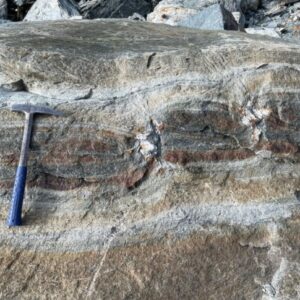There are numerous types of Schist rocks, Mica being one of many.
Mica Schists are the most common Schistose rocks and the second most common metamorphic rocks on Earth. These rocks are composed mainly of Mica (usually Muscovite or Biotite) and smaller amounts of Quartz. The original protolith or parent rock of Mica Schist is Shale.
If you’ve dug and collected Mica Schist and you notice dark red crystals in the host rock or attached to the host rock then you probably have Garnet Mica Schist.

Mica Schist Metamorphic Rock
Schist is foliated metamorphic rocks comprised of plate-shaped mineral grains large enough to see with the naked eye. It usually forms on the continental sides of convergent plate boundaries where sedimentary rocks like Mudstone and Shale have been subjected to heat, compressive forces, and chemical activity.
This metamorphic environment is intense enough to convert clay minerals of the sedimentary rocks into platy metamorphic minerals like Biotite, Chlorite, and Muscovite. Shale must be metamorphosed in steps through Slate to become a Schist, followed by Phyllite. If the Schist metamorphoses further, it can become a granular Gneiss rock.
Micaceous Schist Granite
The word “micaceous” means consisting of, resembling, or containing Mica. It is also defined as of or pertaining to Mica.
Schist rocks are often named according to the minerals we can see without magnification. For instance, Biotite Schist and Muscovite Schist are names commonly used. Names for Schist frequently consist of three words. The dominant metamorphic mineral’s name is second, while the less abundant mineral will be listed first.
However, Micaceous Schist Granite is a Schist that resembles Mica with Granite present and clearly visible.
Quartz Mica Schist
This variety of Schist is one whose foliation is caused primarily by streaks and lenticels of nongranular Quartz. While Mica is present, it is in lesser quantities than in Mica Schist. Another name for these stones is Schistose Quartzite.
Mica Schist Value
Smaller specimens of Mica Schist are generally valued between $5 to $10, depending on the quality. While larger specimens weighing about 15 pounds in excellent condition, with a fine sparkle, can sell for about $100. It is also beneficial to consider where you buy and sell your specimens because prices will vary state-to-state and even from one dealer down the street to another.

Mica Schist Uses
Mica Schist is used for various things. Because it is strong and durable, it is used in building walls and houses. It’s previously been used to create decorative rock walls and is also fashioned into decorative stones and jewelry. There are houses in Australia that were built during the 1800s that are still standing in good condition to this day.
Mica Schist Hardness
This one can get tricky. The Mohs hardness of Mica ranges from 2.5 on cleavage flakes to 4 across cleavage. While Schist is a durable rock with the same hardness as marble, which is a 4 on the Mohs Hardness Scale. That said, depending on the amount of Mica versus Schist, the Hardness can be between 3 to 4.
Where Is Mica Schist Found?
275 million years ago, Africa and America slammed together, creating Pangaea. That is where the stones initially formed. These stones are very common in regions of Archean rocks accompanying Gneisses, Schist varieties, and Crystalline Limestone.
Schist can be found in mountainous regions where metamorphic rocks have been exposed on the surface. The continental side of convergent plate boundaries like the PNW or Pacific Northwest are ideal locations. If Gneiss or Slate can be found in an area, Schist will likely be nearby.

How Is Mica Schist Formed?
Mica Schist has been exposed to a moderate level of heat and pressure. The parent rocks or protoliths of Mica Schist are sedimentary rocks, which are usually Mudstones of Shales.
In these convergent plate boundaries, chemical activity and heat transform clay minerals of Shale and Mudstone into Mica minerals. The directed pressure pushes the transforming clay minerals from their random locations into a common parallel alignment, where they become oriented perpendicular to the direction of the compressive forces. The transformation of these minerals marks the point in the rock’s history where it is no longer considered sedimentary but instead becomes a low-grade metamorphic rock we know as Slate.
When Slate is exposed to further additional metamorphism, the Mica grains within the rock begin to grow. These grains will elongate in a direction that’s perpendicular to the direction of compressive force. The alignment and increase in the Mica grain sizes give the rocks a beautiful silky luster. Once the platy mineral grains grow large enough to see them with unaided eyes, we can now call it Schist. Suppose additional pressure, heat, and chemical activity occur after that point in the transformation. In that case, the Schist can be converted into Gneiss.
Mica Schist may not be as popular and sought-after as Garnets or Rubies, but the stones are beautiful in their own shiny way. Not to mention, they’re useful for building and construction. In the right hands, beautiful decorative jewelry can be made.
- Identify Enstatite - March 12, 2024
- Identify Cerussite - March 3, 2024
- Identify Bytownite - February 18, 2024
